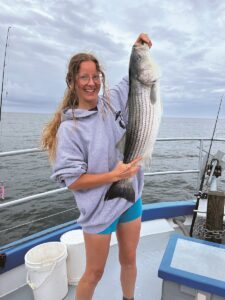Striped bass fishing this season is bordering on epic. We are seeing almost everyone limiting out despite the tight slot-size window we have to deal with.
My mentor, Capt. Francis Bogan, who taught me how to fish when I first started out in Brielle, N.J. and whose family fleet held the International Game Fish Association world record for both cod and pollack for decades, told me two things I’ll never forget. One was this: never leave the lady who loves you. The other was never, ever leave fish to go try to find more fish.

With his words in mind, I did something this week running the Cee-Jay that I haven’t done in a very long time. I fished exactly the same drift with exactly the same GPS starting point and ending point for six consecutive days. All day long. Each day, the boat limited out. That’s a heck of a lot harder to do with 33 passengers on board than it is to limit out on your typical six-pack boat.
Those results are not only testimony to the good lessons I learned from Capt. Francis but to the fact that these fish are stacked up thick and not moving at all.
There are all sorts of prey around for bass to feed on right now. Sand eels are very thick along the edge and in the flats from Wood End to the Race, herring are in the rips, and mackerel, although they’ve left the harbor, are still on the back side and up on the bank. Peanut bunker are starting to show in the harbor as well.
More and more bluefish are beginning to show up, and it’s been good fishing around the Peaked Hill Bar as well as down around Billingsgate Shoals.
You can always tell what’s going on in the water by what creatures suddenly appear or disappear. Looks like a plankton bloom is occurring, as we are suddenly seeing storm petrels showing up as well as mola molas (also known as ocean sunfish), both of which eat zooplankton and algae.
Other signs of a plankton bloom: the water is taking on a familiar green hue, and there’s that slightly sweet melon aroma in the air. Even though the plankton blooms are what bring right whales to our area, this one won’t. The right whales are well north of us in the summer, in and around the Bay of Fundy, and that is where they will stay until it’s time for them to head south to the coast of Florida for calving and breeding.
It was nice to see the tradition of the Blessing of the Fleet continue last Sunday — a chance to honor some of the hardest-working people in our country. Without our fishermen, we would have to rely on seafood from places in the world whose harvesting techniques are both gut wrenching and immoral. I, for one, am very thankful they are still here fighting the good fight to try to make a decent living and provide us with beautiful seafood.



